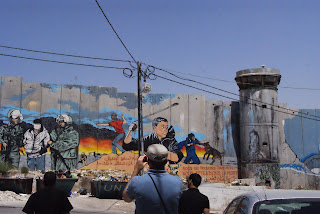The next day we got back to visiting MCC Global Family partners. It certainly was a full day, visiting three partners in one day was almost more then we could take in but the people we met and the work they are doing is amazing.
In the village of Beit Sahour, just outside of Bethlehem, we visited the Al-Malath Society. In Arabic, Al-Malath means "refuge". They serve youth with metal and physical disabilities.
Al-Malath was started by two mom's who have children with disabilities and realized the lack of care and training for youth with disabilities. At Al-Malath they have physical and occupational therapy, music (shown below), life skills (keeping house, grooming, etc.), cooking (the youth help to make lunch each day), arts and crafts and gardening (shown two pictures below).The students were engaged and learning and we could see how meaningful their learnings at Al-Malath were to them. The women who started the school would like to expand from the house they currently use to a large facility where they could engage more youth and have a workshop to employ them. MCC Global Family supports this program in part because of the potential it has to change the communities mindset toward people with disabilities.
Next up, Lajee Center (lajee means "refugee" in Arabic) was established in Aida Refugee Camp in April 2000 by a group of 11 young people from the Camp who wanted to serve the community. Lajee is a community-based grassroots creative cultural center that works with new generations of Palestinians as they continue their ongoing struggle for justice and rights for Palestine and all Palestinians.
The Aida Camp is one of three refugee camps in Bethlehem. Prior to our visit Aida Refugee Camp, I had failed to realize what a refugee camp would look like. Camp = tents, something non-permanent. Wrong.
Salah Ajarma helped to start the Lajee Center is the current director. He was born in Aida camp and has lived there his entire life. He shared his story with us and filled us in on what life in camp is like.
The camp is 60,000 sq. meters (or .2 sq. miles) and 5,000 people live in it. In 1948, the United Nations created the camp when 21 Palestinian villages were destroyed. The UN created the camp as a temporary fix assuming it would two or three weeks before the people could go back home.
They started out in 12m by 6m tens that were split in half to house two families. Salah's grandmother lived in a tent for six years. Here are my verbatim notes from Salah sharing with us:
-1948-1956 people lived in tents
- Sometimes women had to walk for three hours to get water
-Always waiting for the international community to solve the refugee problem.
-Camp has 2 schools, one inside for boys and one outside for girls, they're very crowded and students go in shifts - one in the morning and another in the afternoon
- No clinic in the camp, one clinic in Bethlehem for refugees
- Camp has kept at a population of 5000 for many years now.
This is one of the schools at the camp. If you click on the photo so you can see it better, you'll find the bullet holes in the blue doors left by Israeli soldiers who shot at the school.
Mohammad, a young man from the camp gave us a tour and when we got to the wall with the guard tower looming over the camp and nearby school, I asked him if there were actually guards in the tower. He said, "Sometimes, we never know and you can't see through the dark windows to find out."
From the roof of the Lajee Center we looked down on the park space the center is renting with plans to purchase. It's the only green space in the camp, the only place children can run and play without being in a street or on concrete.
Our third MCC visit of the day was done via Skype since we couldn't get into the Gaza Strip for an in-person visit. We met two students at the Culture and Free Thought Association in Khan Younis, Gaza. They work with kids ages 6-12 years old through art, theater, media, sports and more. They encourage the kids to be in charge of all activities and the children run the summer camps (with adult supervision). It seemed like an amazing way to teach leadership and life skills all while having a great time.
This is Ahlam, age 11, she spoke with such confidence and hope for her future. She most enjoys working on computers while she's at the center. She won the student election to be in charge of the summer camp this year so now she goes around asking the kids about what food, toys, activities they want and she works with the teachers to make it happen. She dreams of being a teacher.
And this is Farah, age 11 as well. If the center wasn't available she'd have to stay home and care for her younger brothers. She said she used to be shy and wouldn't talk to people and now she's confident and not shy. She loves learning English, Islamic religions, hates science and doesn't like math. She dreams of being a doctor.
Basam, who works for MCC Palestine worked hard interpreting the entire Skype call and did a great job helping us communicate with the girls.
The girls just amazed me. Such confidence, such strength, such joy in their smiles and expressions. I hope their dreams become their realities.
The girls asked that the following message be sent to children in the US and Canada - they'd like the siege lifted, rights, free to play and they'd like others to hear their voices.
















No comments:
Post a Comment